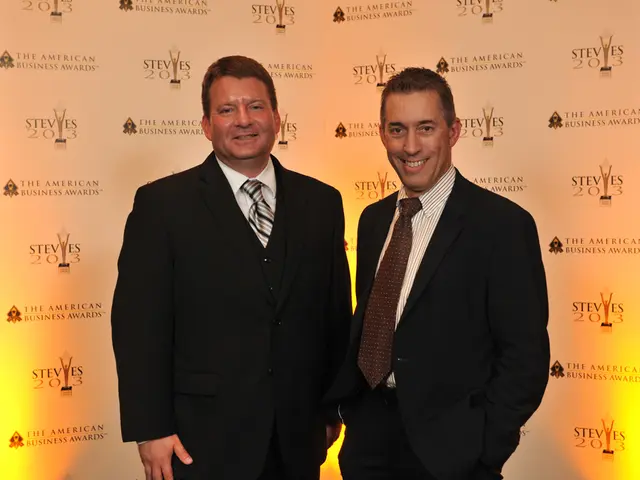Unmasking Synthetic Media: Strategies for Identifying and Mitigating Deepfakes
In the digital age, the emergence of deepfakes poses a significant challenge to authenticity and trust. These AI-generated media, typically videos or audio, manipulate or fabricate content, making it appear as if someone said or did something they didn't [1].
To counter this growing threat, innovative solutions are being developed. AI-powered detection tools, such as Cyabra and Pindrop, analyze media for signs of manipulation, integrating video, image, and voice analysis [1][3]. Real-time liveness and machine learning verification technologies, like those employed by Pindrop, are also being used to distinguish synthetic voices from real ones [3][5].
On the regulatory front, the U.S. government is addressing deepfake threats through legal and policy frameworks. The White House’s 2025 AI Action Plan includes proposed updates to the Federal Rules of Evidence specifically related to deepfakes [2][4]. These efforts signal a move towards formalizing evidence rules and potentially imposing greater responsibilities on tech companies to identify, label, and remove deepfake content.
Regulations demanding labeling/removal of deepfakes and increased penalties are also being proposed [5]. The DEEPFAKES Accountability Act, for instance, aims to target malicious deepfake creation, particularly in fraud and revenge porn cases [6].
Public awareness initiatives are another crucial component in the fight against deepfakes. Digital literacy programs are being developed to educate people on spotting and avoiding fake media [5]. The Content Authenticity Initiative (CAI) embeds metadata into images and videos, allowing users to verify their source [7].
Ethical and privacy concerns arise due to the need for access to large datasets for deepfake detection. Particularly when individuals have not consented to their likeness being used for detection purposes [8]. China, for example, has criminalized deepfake misuse and mandates that AI-generated content be clearly labeled [9].
Collaborative efforts, standardization, and regulations for digital integrity are key to combating the deepfake challenge effectively. Open-source and community tools, such as DFDC Dataset & Model, DeepSafe, Sensity AI, and DeepStar, are available for deepfake detection [10].
However, rapidly advancing deepfake technology makes it more challenging for both humans and traditional detection tools to distinguish real from fake. AI-driven deepfake detection systems struggle as deepfake technology advances [11]. Over 90% of respondents in a survey conducted by The Alan Turing Institute are worried about the spread of deepfakes [12].
In summary, combating deepfakes involves AI-powered detection tools integrating video, image, and voice analysis, real-time liveness and machine learning verification technologies for voice and video, legal updates such as changes to Federal Rules of Evidence, proposals for regulations demanding labeling/removal of deepfakes and increased penalties, digital literacy programs to improve public resilience against deception, and collaborative efforts, standardization, and regulations for digital integrity.
References: 1. Cyabra Deepfake Detection Tool 2. White House 2025 AI Action Plan 3. Pindrop Voice Biometrics 4. Proposed Updates to Federal Rules of Evidence 5. Addressing Deepfakes: Strategies and Solutions 6. DEEPFAKES Accountability Act 7. Content Authenticity Initiative 8. Ethical and Privacy Concerns in Deepfake Detection 9. China's Regulation on Deepfakes 10. Open-Source Deepfake Detection Tools 11. AI-Driven Deepfake Detection Systems 12. Alan Turing Institute's Deepfake Survey 13. Our Website: Hassle-Free Verification for Businesses
- The emergence of deepfakes in data-and-cloud-computing, a product of artificial-intelligence, has raised concerns about authenticity and trust.
- These AI-generated media, typically videos or audio, can manipulate or fabricate content, making it appear as if someone said or did something they didn't [1].
- To counter this growing threat, technology innovators are developing AI-powered detection tools, such as Cyabra and Pindrop, to analyze media for signs of manipulation.
- These tools integrate video, image, and voice analysis for detection [1][3].
- Real-time liveness and machine learning verification technologies, like those employed by Pindrop, are being used to distinguish synthetic voices from real ones [3][5].
- The U.S. government is addressing deepfake threats through legal and policy frameworks, including proposals for updates to the Federal Rules of Evidence specifically related to deepfakes [2][4].
- These efforts signal a move towards formalizing evidence rules and potentially imposing greater responsibilities on tech companies to identify, label, and remove deepfake content.
- Regulations demanding labeling/removal of deepfakes and increased penalties are being proposed, such as the DEEPFAKES Accountability Act [6].
- Public awareness and education are crucial components in the fight against deepfakes, with digital literacy programs being developed to educate people on spotting and avoiding fake media [5].
- The Content Authenticity Initiative (CAI) embeds metadata into images and videos, allowing users to verify their source [7].
- Ethical and privacy concerns arise due to the need for access to large datasets for deepfake detection, particularly when individuals have not consented to their likeness being used for detection purposes [8].
- China has criminalized deepfake misuse and mandates that AI-generated content be clearly labeled [9].
- Collaborative efforts, standardization, and regulations for digital integrity are key to combating the deepfake challenge effectively.
- Open-source and community tools, such as DFDC Dataset & Model, DeepSafe, Sensity AI, and DeepStar, are available for deepfake detection [10].
- However, rapidly advancing deepfake technology makes it more challenging for both humans and traditional detection tools to distinguish real from fake.
- AI-driven deepfake detection systems struggle as deepfake technology advances [11].
- Over 90% of respondents in a survey conducted by The Alan Turing Institute are worried about the spread of deepfakes [12].
- In the realm of education-and-self-development, focusing on personal-growth and career-development can help individuals navigate the challenges posed by deepfakes.
- Gaining skills-training in areas like sports-betting, tennis, and sports-analysis can provide opportunities for career growth, while hobbies like baseball, football, basketball, hockey, golf, and mixed-martial-arts offer avenues for personal growth and stress-relief during these challenging times.







